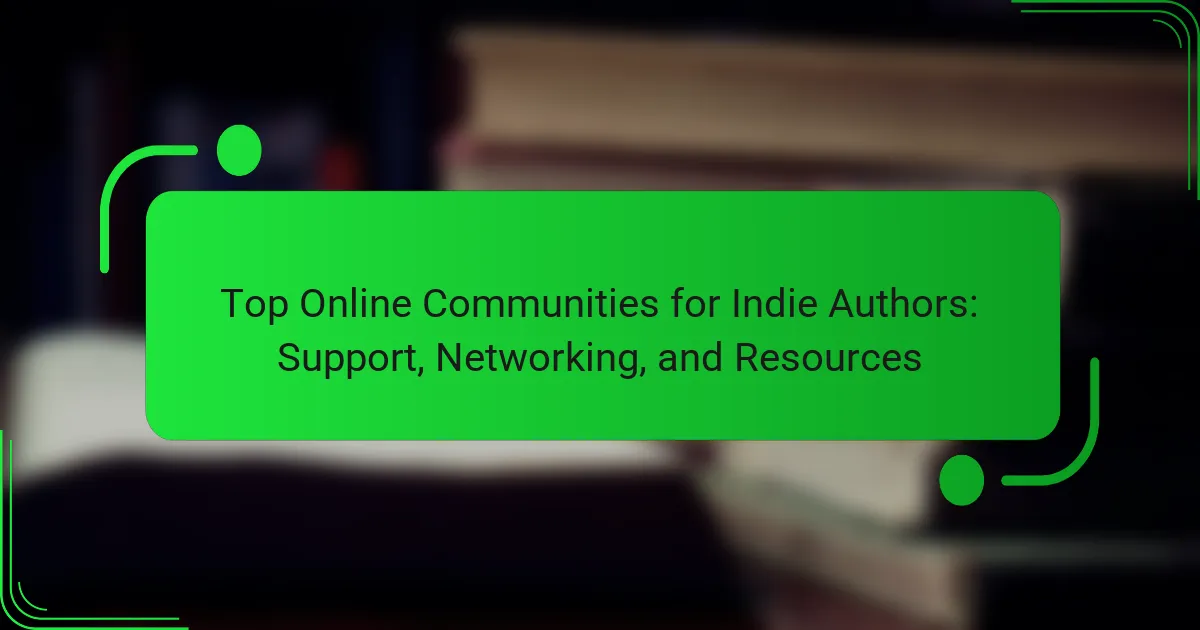Indie author collaboration tools enhance productivity and streamline the writing process. This article explores their benefits, including improved workflow and networking opportunities. It also highlights popular platforms like Google Docs, Trello, and Slack. Additionally, we address challenges such as communication barriers and cultural differences, and discuss future trends in collaboration tools.

What are Indie Author Collaboration Tools?
Indie author collaboration tools streamline the writing process, enhance creativity, and foster community among writers. These tools include platforms for co-writing, project management, and communication. They offer benefits like improved workflow, shared resources, and networking opportunities. Popular examples include Google Docs for real-time editing, Slack for communication, and Trello for project organization.
How do these tools enhance the writing process?
Indie author collaboration tools streamline the writing process by facilitating communication, project management, and resource sharing. These tools enhance productivity through features like real-time editing, feedback mechanisms, and file sharing. They foster a supportive community, enabling authors to exchange ideas and improve their work collaboratively. Additionally, they often include organizational features that keep projects on track, ensuring deadlines are met and goals are achieved.
What features are commonly found in collaboration tools?
Collaboration tools for indie authors commonly feature document sharing, real-time editing, communication channels, task management, and version control. These features enhance productivity and streamline the collaborative writing process. Document sharing allows authors to access and edit files easily. Real-time editing enables simultaneous contributions, fostering creativity. Communication channels facilitate discussions and feedback. Task management helps organize writing schedules and deadlines. Version control tracks changes, ensuring all contributions are documented effectively.
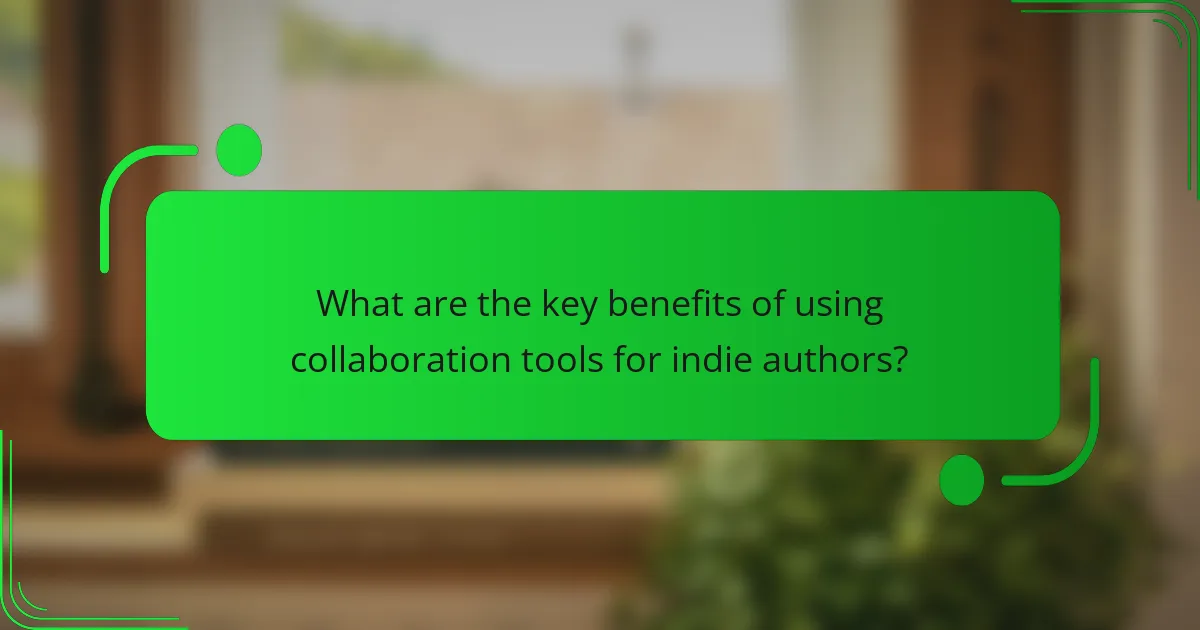
What are the key benefits of using collaboration tools for indie authors?
Collaboration tools offer indie authors enhanced communication, streamlined project management, and increased productivity. They foster networking opportunities, allowing authors to connect with peers for feedback and support. These tools also facilitate real-time editing and sharing, ensuring consistent progress on projects. Overall, they empower indie authors to collaborate effectively, ultimately improving their writing and publishing outcomes.
How do collaboration tools improve productivity?
Collaboration tools enhance productivity for indie authors by streamlining communication and project management. These tools facilitate real-time feedback, ensuring that all team members stay aligned on goals and deadlines. Increased efficiency leads to faster project completion and improved creativity through collective brainstorming. Popular examples include Google Docs for document sharing and Trello for task management.
In what ways do these tools foster community among authors?
Indie author collaboration tools foster community among authors by enabling communication, sharing resources, and facilitating joint projects. These tools create platforms for networking, allowing authors to connect and support each other. Features like forums, group chats, and project management enhance collaboration, leading to shared learning experiences. Additionally, they often provide opportunities for co-authoring, which strengthens relationships and builds a sense of belonging within the indie author community.
What cost savings can indie authors achieve with collaboration tools?
Indie authors can achieve significant cost savings through collaboration tools by reducing expenses related to editing, marketing, and distribution. These tools streamline communication and project management, enabling authors to share resources and skills effectively. For example, using shared editing platforms can cut down on hiring costs for professional editors, while collaborative marketing efforts can lower promotional expenses. Overall, collaboration tools help indie authors maximize their budgets and increase their reach.
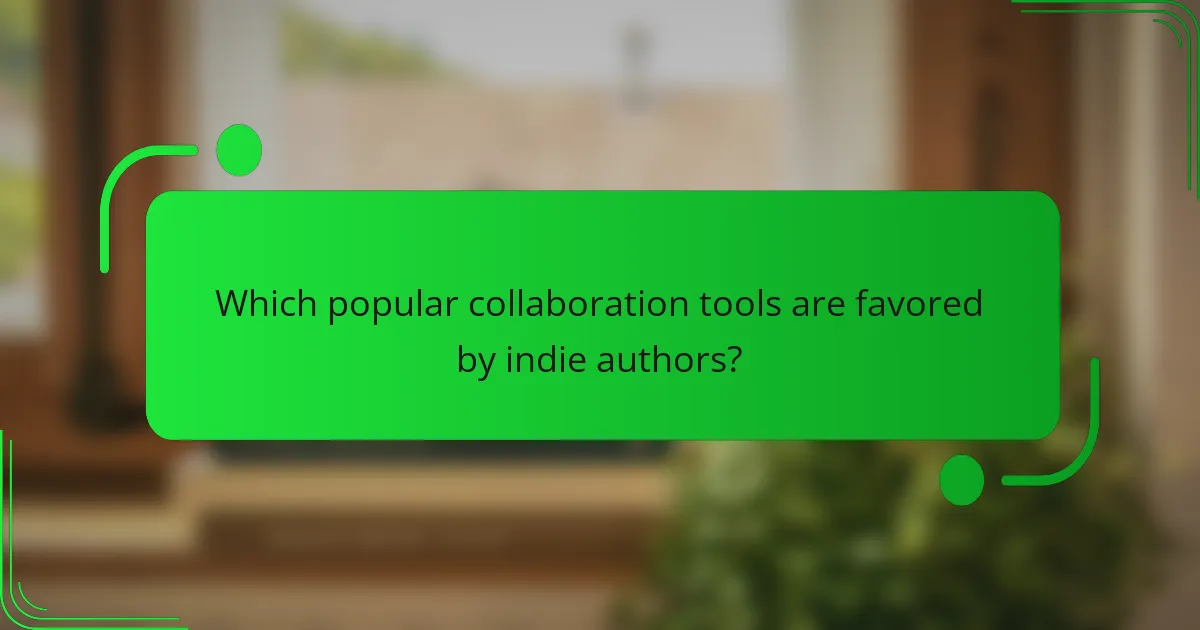
Which popular collaboration tools are favored by indie authors?
Indie authors often favor tools like Google Docs, Trello, Slack, and Dropbox for collaboration. These platforms enhance communication, streamline project management, and facilitate file sharing. Google Docs allows real-time editing, while Trello organizes tasks visually. Slack provides instant messaging, and Dropbox offers ample storage for documents.
What are the unique features of specific tools like Google Docs and Scrivener?
Google Docs offers real-time collaboration and cloud storage, while Scrivener provides advanced organizational tools for long-form writing. Both tools cater to indie authors but differ significantly in functionality. Google Docs supports simultaneous editing and commenting, enhancing teamwork. Scrivener’s unique features include a corkboard for storyboarding and a split-screen view for research and writing integration. Additionally, Scrivener allows for extensive project management, making it ideal for complex manuscripts.
How does the user experience differ across various platforms?
User experience varies across platforms due to differences in interface design, functionality, and accessibility features. Indie author collaboration tools may perform differently on desktop versus mobile, affecting usability. For instance, desktop versions often provide more robust features, while mobile apps focus on streamlined functionality for on-the-go access. Additionally, the integration of cloud services can enhance collaboration by allowing real-time updates, but performance may vary based on internet connectivity. Understanding these differences helps authors choose the right tool for their needs.
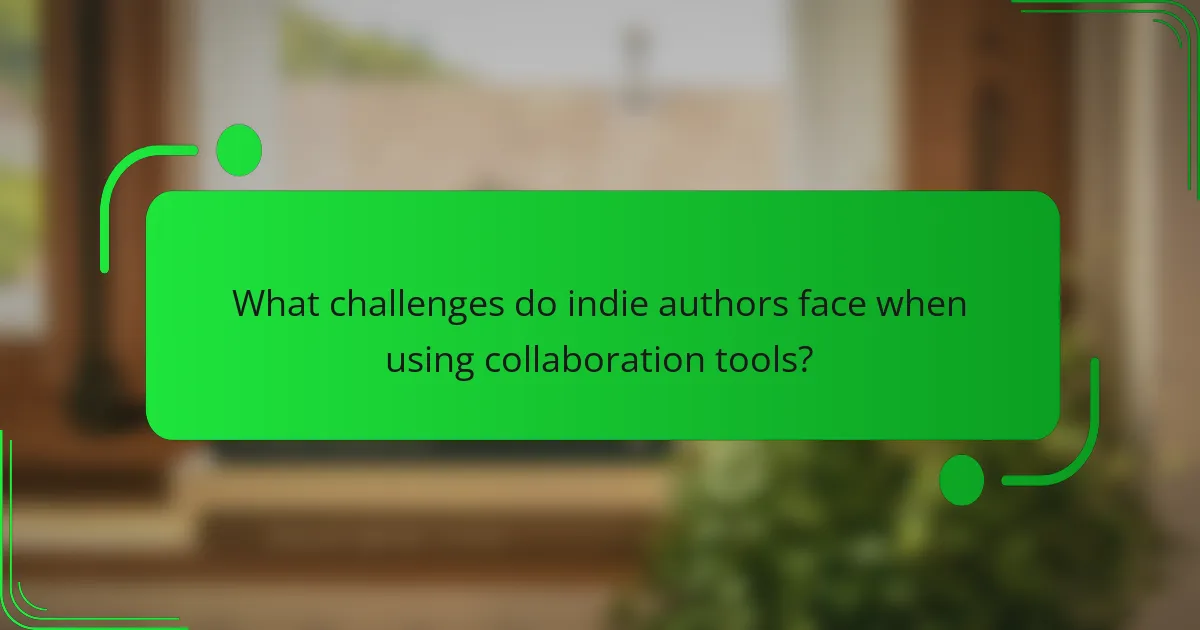
What challenges do indie authors face when using collaboration tools?
Indie authors face several challenges when using collaboration tools, including technical difficulties, communication barriers, and varying levels of tool proficiency. These obstacles can hinder productivity and project cohesion. Additionally, managing feedback and maintaining creative control can be complex with multiple collaborators involved.
How can technical issues impact collaboration?
Technical issues can significantly hinder collaboration among indie authors by disrupting communication and workflow. Problems such as software glitches, connectivity issues, and compatibility challenges can lead to misunderstandings and delays. For instance, if a co-author cannot access a shared document due to technical difficulties, it stifles productivity and creativity. Moreover, reliance on specific tools may create barriers if team members are not equally proficient or equipped with the necessary technology. Addressing these issues promptly is essential to maintain a seamless collaborative environment.
What are common misunderstandings about collaboration tools?
Many misunderstandings about collaboration tools stem from misconceptions about their functionality and usage. Users often believe these tools are only for large teams, overlooking their benefits for indie authors. Some think collaboration tools hinder creativity, while they can actually enhance it by facilitating idea sharing. Additionally, there is a belief that these tools are too complex, but many are designed to be user-friendly and intuitive. Lastly, some authors assume that collaboration tools are only for real-time communication, ignoring features that support asynchronous collaboration, which can be crucial for independent writers.
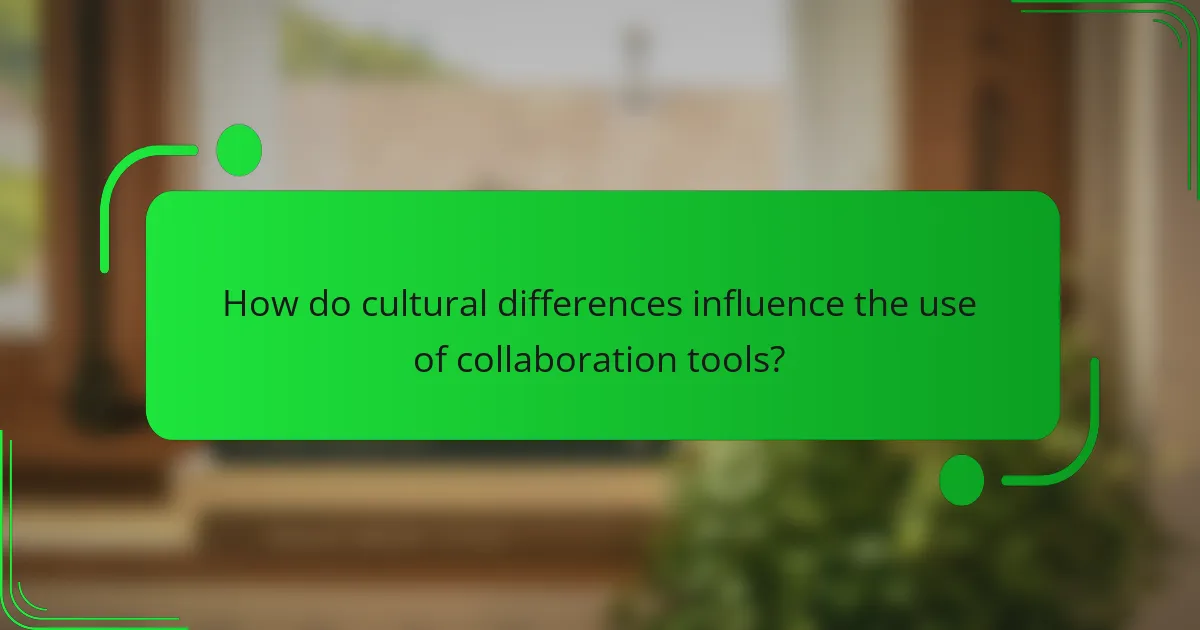
How do cultural differences influence the use of collaboration tools?
Cultural differences significantly impact the use of collaboration tools among indie authors. These tools reflect varying communication styles, preferences, and values shaped by cultural backgrounds.
For instance, authors from collectivist cultures may favor tools that promote group consensus and shared ownership, while those from individualistic cultures might prefer tools that allow for personal expression and autonomy.
Additionally, language barriers can influence tool selection, with some authors opting for platforms that support multiple languages or offer translation features. Understanding these cultural nuances can enhance collaboration effectiveness and foster a more inclusive environment for diverse authors.
What regional preferences exist for specific tools?
Regional preferences for indie author collaboration tools vary significantly. In North America, tools like Google Docs and Slack are favored for their integration and real-time collaboration features. European authors often prefer platforms like Trello and Asana, valuing project management capabilities. In Asia, tools such as WeChat and Notion are popular due to their multifunctional use and accessibility. Cultural factors also influence these preferences, with some regions prioritizing tools that support local languages and communication styles. Understanding these regional nuances can enhance collaboration effectiveness among indie authors.
How does collaboration style vary among authors from different backgrounds?
Collaboration style among authors from different backgrounds varies significantly due to cultural influences and individual experiences. For instance, authors from collectivist cultures often emphasize group consensus, while those from individualistic backgrounds may prioritize personal expression. This diversity enriches the collaborative process, leading to unique creative outcomes. Additionally, factors like language proficiency and access to technology can further shape collaboration dynamics. Understanding these variations can enhance the effectiveness of collaboration tools tailored for indie authors.

What are the future trends in collaboration tools for indie authors?
Future trends in collaboration tools for indie authors focus on enhanced integration, real-time feedback, and AI-driven support. These tools will increasingly utilize cloud technology for seamless access and collaboration across devices. Additionally, features like virtual writing rooms and community-building platforms will foster networking and mentorship among authors. As remote work continues to rise, tools that prioritize user experience and streamline project management will become essential for indie authors.
How is technology evolving to meet the needs of indie authors?
Technology is evolving to support indie authors through innovative collaboration tools. These tools enhance communication, streamline project management, and facilitate networking among authors.
Recent platforms provide features like real-time editing, shared resources, and feedback systems. For instance, tools like Scrivener and Google Docs enable seamless collaboration, allowing multiple authors to contribute simultaneously.
Additionally, social media platforms and dedicated forums foster community engagement, providing indie authors with opportunities to share experiences and resources. This collaborative environment encourages creativity and increases visibility for indie projects.
As a result, indie authors can leverage these technological advancements to enhance their writing process, improve productivity, and build supportive networks.
What emerging features should authors look for in new tools?
Authors should look for features that enhance collaboration, streamline communication, and integrate with existing platforms. Emerging tools are increasingly offering real-time co-editing capabilities, improved project management functionalities, and AI-driven insights for content optimization. These attributes foster a more efficient and engaging writing process. Additionally, features like customizable templates and analytics dashboards can provide valuable data to track progress and performance.
What best practices should indie authors follow when using collaboration tools?
Indie authors should prioritize clear communication, establish roles, and set deadlines when using collaboration tools. Effective practices include selecting user-friendly platforms, maintaining regular check-ins, and utilizing shared documents for transparency. These strategies enhance collaboration efficiency and ensure project alignment.
